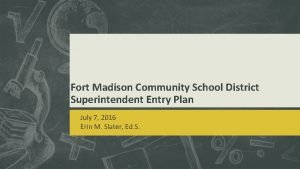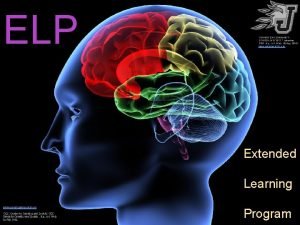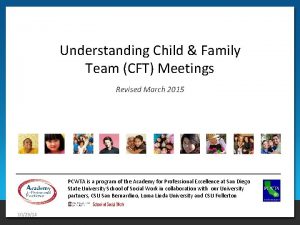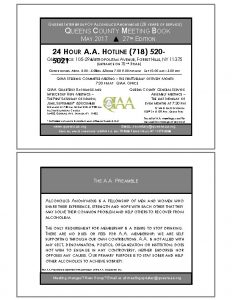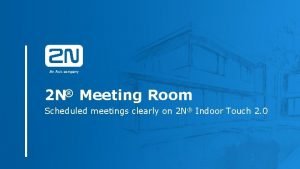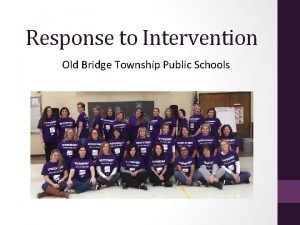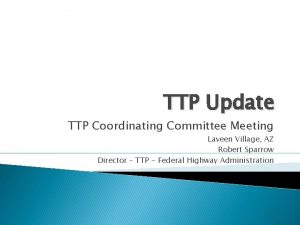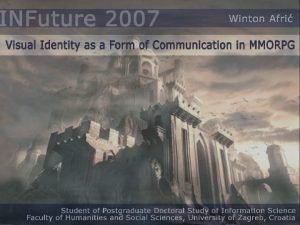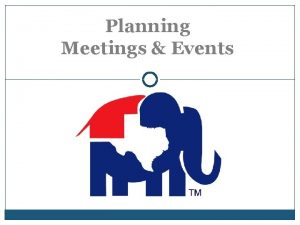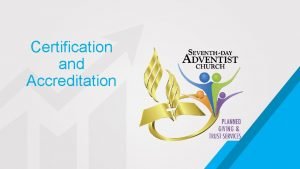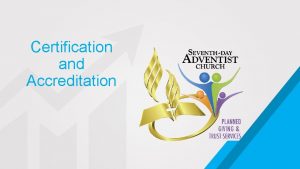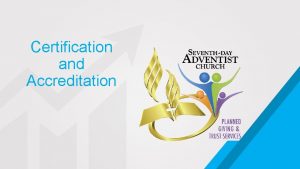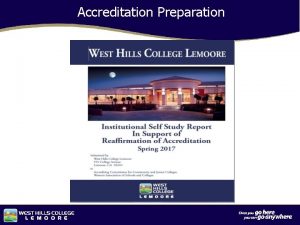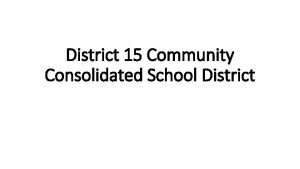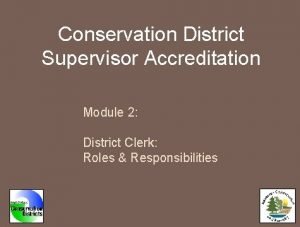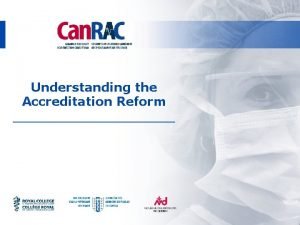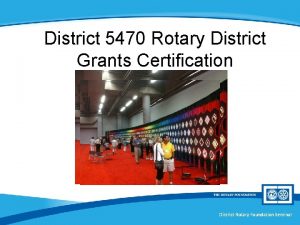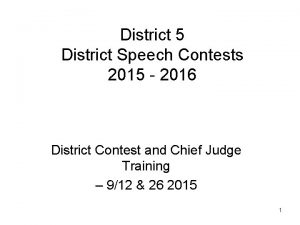District Accreditation Community Meetings Overview Accreditation is a



















- Slides: 19

District Accreditation Community Meetings

Overview Accreditation is a method of quality assurance. The process is used at all levels of education, and is recognized for its ability to effectively drive student performance and continuous improvement in education. The accreditation process is collaborative. By bringing together all those who are invested in your district’s success, you build support for your vision and goals. The Advanc. ED Accreditation Process is truly comprehensive. The process focuses on your organization’s vision and goals, evaluates teaching and learning, and examines how results are documented and resources are allocated. School Districts participate in an external review, completed by a team of highly qualified external peer evaluators who examine the institution’s adherence and commitment to Advanc. ED Standards.

Standards Addressed Standard 1: Purpose and Direction - Level 3 The school maintains and communicates a purpose and direction that commit to high expectations for learning as well as shared values and beliefs about teaching and learning. Standard 2: Governance and Leadership - Level 3 The school operates under governance and leadership that promote and support student performance and school effectiveness. Standard 3: Teaching and Assessing for Learning - Level 3 (2) The school’s curriculum, instructional design, and assessment practices guide and ensure teacher effectiveness and student learning. Standard 4: Resources and Support Systems - Level 3 (2) The school has resources and provides services that support its purpose and direction to ensure success for all students. Standard 5: Using Results for Continuous Improvement - Level 3 (1) The school implements a comprehensive assessment system that generates a range of data about student learning and school effectiveness and uses the results to guide continuous improvement.

Summary of 2008 Visit Commendations 1. District demonstrated and modeled the use of the Standards Assessment Report to engage a wide variety of stakeholders through the accreditation process. 2. Leadership provides a strong direction and framework for continuous improvement. 3. Professional learning and development at all levels are seen as a high priority. 4. Board, Superintendent and administrative staff works closely as a team to provide informed and effective leadership. Report of the Quality Assurance Review Team for Duval County Public Schools pg. 6

Summary of 2008 Visit Recommendations 1. Engage in causal analysis to gain deeper insight into the achievement gap so that equity can be attained. 2. Create coherence and completeness to the assessment system so it effectively informs and guides teaching and learning. 3. Evaluate programs and initiatives to identify what works, develop procedures that are matched and/or aligned with needs, being implemented properly, and set up for sustainability. 4. Examine communication system in order to message and successfully reach all stakeholders. 5. Devise and implement system-wide procedures to ensure collaborative horizontal planning and vertical articulation. * Report of the Quality Assurance Review Team for Duval County Public Schools pg. 7 -8

Update on 2008 Recommendations Recommendation Action Steps Engage in casual analysis to gain deeper insight into the achievement gap so that equity can be attained. The FDOE transition to Annual Measurable Objectives (AMO’s) vs. AYP allows for schools and districts to establish systems and goals that support the ability to address the achievement gap in a substantive manner within an appropriate timeline. Create coherence and completeness to the assessment system so it effectively informs and guides teaching and learning. The district has revised the existing curriculum frameworks and curriculum guides along with interim assessments as a means to better inform instructional pacing, acceleration, and intervention.

Recommendations cont. Recommendation Action Steps Evaluate programs and initiatives to identify what works, develop procedures that are matched and/or aligned with needs, being implemented properly, and set up for sustainability. The newly adopted Strategic Plan clearly defines the district goals and initiatives. More importantly each area is linked to a performance measure to support its completion and to ensure accountability at all levels of leadership. Examine communication system in order to message and successfully reach all stakeholders. The district has revamped the communication division to focus on messaging and marketing. In addition, the purchase of Connect Duval, School Wires, and Share. Point will allow the district to enhance our communication process for both essential and emergency communications at the individual stakeholder level (parent, student, teacher, administration, community). Devise and implement system-wide procedures to ensure collaborative horizontal planning and vertical articulation. The establishment of Regions based upon feeder pattern will better support the vertical and horizontal alignment and planning. The school patterns will look at the comprehensive nature of students needs through a PK-13 lens in order to promote alignment and continuity of process/outcomes.

District Accreditation versus School Based Ensure a holistic view of our district, we are seeking district accreditation. Vision to truly see how the many working parts come together to support schools and directly increase student achievement. Cost effective as it saves the district a considerable amount of money vs. the individual site model.

Fiscal Impact Total Cost: $105, 400. 00 Annual Fee Cost per school: $650. 00 New schools: Marine Science Center Duval Virtual Instruction Academy Schools for the Future James Weldon Johnson Academic and Career Training Center

School Assignments and Timeline Deliverable Date Completion of School Profile August 1, 2013 Completion of School Self Assessment August 15, 2013 School shares profile and self assessment with SAC, PTSA and Stakeholder groups (post to school websites) Sept 1, 2013 District reviews school submissions and edits for consistency and alignment October 1, 2013 Final approval by district October 15, 2013

Status of School Deliverables Deliverable Date Due Completed Y/N Follow Up Needed Surveys August 2013 Y NA Profile September 2013 Y NA Self Assessment Rating (SAR) October 31, 2013 Y NA Assurances October 31, 2013 Y NA Upload SIP October 31, 2013 Y NA Include SAR review and share anecdotal with SAC, PTSA, and Staff November 2013 – January 2014 Y NA Upload School Safety/Emergency Management Plan December 1, 2013 Y Y Executive Summary December 1, 2013 Y Y

Schools cont. Deliverable Date Due Completed Y/N Follow Up Needed Stakeholder Performance Diagnostic (based upon surveys already collected leads to the identification of barriers and establishment of actionable items) January 31, 2014 On Going Webinar, Support Sessions, School Visits Student Performance Diagnostic (based on test data) January 31, 2014 On Going Webinar, Support Sessions, School Visits

Status of District Deliverables Deliverable District Profile Date Due July 2012 Completed Y/N/P Follow Up Needed Y N 3 of 4 sections completed Yes requires 3 year performance data to be updated when HS grades are released Y Discussion with stakeholders secure anecdotal evidence Diagnostics Executive Summary October 2013 Self Assessment Rating (SAR) October 2013 Student Performance Diagnostic January 31, 2014 In Progress Stakeholder Diagnostic Feedback January 31, 2014 Y Assurances Goals Y November 30, 2013 Y

District Deliverables Deliverable Date Due Completed Y/N Collection Of Artifacts and Evidence March 25, 2014 In Progress Superintendent’s Overview March 25, 2014 TBD November 2013 – February 2014 Ongoing Include SAR review and share anecdotal with all stakeholders (PTSA, DAC, CAT, NAACP, and ESEAC) Follow Up Needed

Sample Community Meetings Stakeholder Meetings Date School Advisory Committee (District) November –January 2013 NAACP TBD Community Advisory Team (CAT) December 5 th, 2013 (5: 30 Southside Middle School) District Advisory Committee (DAC) January 27 th PTSA TBD Board Workshop TBD LULAC TBD ESEAC January 27 th

Division Meeting Attendees Finance Edwards and TBA Operations Soares and TBA Safety Ford, Roziers, Moore, Coffman Curriculum and Instruction Simic, Sharp, and TBA Assessment and Accountability Post and TBA Program Alignment P. Roziers, C. Dahnke, J. Davis, Human Resources Young, Chastain Communications Oliver Parental Engagement K. Davis Purpose Outline next steps for the collection and submission of evidence

Visitation Summary Systems Overview and Standards Presentations Superintendent provides general orientation to team. System personnel provide brief presentation on the system's adherence to each of the five standards and highlight key artifacts related to the Standard. Interviews Team interviews system leadership and improvement team, teachers, parents and community members, support staff and students (each interview is approximately 45 minutes) Artifact Review Team reviews system artifacts (this occurs on an on-going basis)

Visitation Summary continued Observations at Schools Selected for Visits Principal and/or designee provides an instructional tour of the school Team conducts classroom observations Team makes general observations throughout the review Professional Deliberations Team meets to examine the data collected and reach consensus regarding the team's findings Meeting with the Superintendent Prior to the delivery of the Exit Report, the Lead Evaluator meets with the Superintendent to review the team’s findings and discuss the team’s required actions Exit Report Lead Evaluator provides Exit Report to the system’s stakeholders at the conclusion of the review.

Contacts System Facilitator: • Fred Heid, Chief Academic Officer 390 -2660 Desk heidf@duvalschools. org • Lindsay Sharp, Executive Director of Instruction 390 -2926 Desk peranil@duvalschools. org
 Bloody meetings
Bloody meetings Meetings bloody meetings 5 points
Meetings bloody meetings 5 points Meetings bloody meetings
Meetings bloody meetings Fort madison community school district
Fort madison community school district Glenwood community school district
Glenwood community school district Johnston community school district
Johnston community school district What is a cft meeting
What is a cft meeting Chairing skills
Chairing skills Parting thoughts for meetings
Parting thoughts for meetings Benefits of virtual meetings
Benefits of virtual meetings Queens aa intergroup
Queens aa intergroup N meetings in one room
N meetings in one room Meetings incentives conventions and exhibitions (mice)
Meetings incentives conventions and exhibitions (mice) What are the seven parts of the ffa emblem
What are the seven parts of the ffa emblem Disruptive behavior in meetings
Disruptive behavior in meetings Meetings plus
Meetings plus Easycbm old bridge
Easycbm old bridge Aa meetings in laveen
Aa meetings in laveen Virtual meetings
Virtual meetings Webex meeting vs webex teams
Webex meeting vs webex teams



